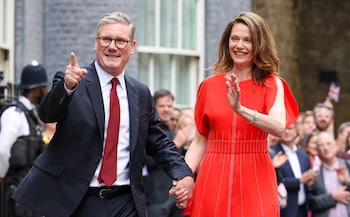Testosterone may be the world’s most discussed hormone. With the Olympics approaching, its performance-boosting powers will soon be under the spotlight again. When prisons are overcrowded, crime levels rise, testosterone is fingered as the culprit. In 2008, the chair of the International Monetary Fund even blamed it for the financial crash, saying: “I honestly think that there should never be too much testosterone in one room.”
“We’ve chosen to vilify testosterone because of its mis-association with aggression. But that’s just factually incorrect,” says Dr Rob Stevens, founder of The Men’s Health Clinic in Dorset. “Testosterone is actually a calming hormone. It’s the counterbalance to cortisol – the stress hormone.”
In fact, we may have got testosterone all wrong. A 2022 review of available studies found no association between the hormone and muscle mass, strength or performance in women. Other rigorous studies have found little relationship between it and anger. In fact, a growing body of research suggests that for men, and in fact for women too, it can sometimes be the key to improving your midlife health and relationships.
What is testosterone?
The hormone got its name in 1935, when Ernest Laqueur isolated it from bull testes. But people (mostly, it must be said, men) had been excited for centuries about a substance that, once extracted from testicles, might bestow mythical powers of masculinity on its recipient. Injectable serums were made from dog and guinea pig testicles in the 1880s. By the 1920s, a Russian surgeon called Serge Abrahamovitch Voronoff was doing a roaring trade in inserting slices of baboon and chimpanzee testicles into the scrotums of human patients, while making dazzling claims for the impact on memory, eyesight and libido. As researchers Rebecca Jordan-Young and Katrina Karkazis write in their book Testosterone, An Unauthorised Biography, “it’s a lot to pin on a simple molecule” which in fact, is: “neither the biological essence of manliness nor even ‘the male sex hormone’.”
So what do we know about testosterone’s impact? Well it’s true that, in men, testosterone is principally produced in the testicles, and plays a vital role in sperm production and sex drive. But it also affects bone and muscle mass, fat distribution, and the production of red blood cells.
Nor is it just for men. Women make it in their ovaries too. In fact, as Jordan-Young and Karkazis point out, it is the single most abundant biologically active female hormone, essential for women’s physical and mental health. Alongside oestrogen and progesterone, it helps support ovulation but also contributes to lean body mass, bone health, cognition, mood and more. So, it is not only confined to the sex organs. Testosterone receptors are found in almost all tissues in the human body.
What happens to testosterone levels in midlife?
Men’s testosterone levels peak during adolescence and early adulthood. After 30, they decline by around one per cent each year, till – aged 70 – your levels are likely to be around 30 per cent lower than at their peak.
This, Stevens stresses, does not imply that men are going through anything similar to the menopause: “there’s no such thing as the male menopause.” But the process can be gruelling for some, especially in the modern world: “I’ve got plenty of patients in their 50s who come for screening and find they have very healthy testosterone levels,” he says. “That’s normally as a result of leading a healthy, active life and not being under the constant psychological pressure that many of us suffer as a consequence of our psychologically challenging jobs.”
Women, meanwhile, get a spike of testosterone around the time of ovulation, explains Dr Kim Ruddy, GP and menopause specialist. These spikes get gradually shallower once you leave your 20s behind. Unlike oestrogen and progesterone levels, which change dramatically during the perimenopause: “it’s a gradual deterioration with age, says Ruddy. “It doesn’t suddenly strike you but by the time you’re in your 50s, it’s very normal to have low testosterone.”
Low testosterone in men – the consequences
This gradual slide may sound depressing, but it does not necessarily cause problems. A 2002 study found no link between the process and risk of erectile dysfunction. Another suggests no relationship with mortality rates either.
For some men however, the impact can be profound. The NHS will prescribe testosterone replacement therapy to men with pathological hypogonadism (a diagnosed shortage of the hormone), as it is proven to improve sexual function in such cases. Yet for many others, says Stevens, “the symptoms have very little to do with libido. The major presenting symptoms in my clinic are mental discord, whether that manifests as low mood or anxiety, then fatigue, then brain fog, and only after that comes reduced libido.”

Low testosterone in women – the consequences
“Historically, testosterone has not been considered to be particularly important for woman in midlife,” says Ruddy. “The main focus has been around trying to manage hot sweats and other miserable symptoms of the menopause.” Yet, she says: “many women are frustrated by the lack of libido that this brings. It can have a big impact on self-esteem and relationships.”
In fact: “about 25 per cent of menopausal women will suffer from hypoactive sexual desire disorder (HSDD),” explains Dr Louise Newson, GP, menopause expert and the founder of Newson Health. “Basically, they’ll get a really low libido. Testosterone has been shown to help significantly with that.”
A 2020 review of trials concluded decisively that, compared to either a placebo or oestrogen and progesterone HRT, testosterone therapy “increased sexual function including satisfactory sexual event frequency, sexual desire, pleasure, arousal, orgasm, responsiveness and self-image”.
NICE guidelines now allow for testosterone to be prescribed to women suffering from low libido. “But what I’ve found is that for most women, when they’ve been on it for six months or so, they start describing additional benefits,” says Ruddy. “It makes them feel a bit sharper, they feel more comfortable in their body, they sleep better, they report better brain function.”
The different ways of taking testosterone
Perhaps unsurprisingly then, NHS prescriptions for testosterone for menopause have increased by around tenfold over the last decade. But here’s the rub. “In the NHS we can only prescribe sachets of a gel called Testogel, or another in a pump called Testim,” says Ruddy. “Both are basically male products. Where men can just open the sachet and use the whole thing, women have to estimate an 8th of a sachet to apply each day,” explains Ruddy. A licensed female-specific product, AndroFem, is only available privately.
The landscape is rather different for men. In addition to these products, the NHS also prescribes three-monthly injections of a long-acting formulation called Nebido, and Sustanon – a combination of four forms of testosterone that requires injection every two to four weeks. Go private, and the possibilities expand still further. Stevens’ clinic, for example, prescribes daily injections, which patients give themselves at home. These microdoses “mimicking the body’s physiology as closely as possible,” he explains, creating more stable and steady levels.
What are the side effects?
For women, the most common side effects are excess hair growth, acne and weight gain, says the British Menopause Society. These usually settle down with a decreased dosage, stresses Ruddy.
Cardiovascular complications have traditionally been the biggest worry for men. In 2023, however, a major study published in The New England Journal of Medicine found that the risk of “major adverse cardiac events” was not raised by the use of TRT.
Testosterone treatment can also cause an enlarged prostate or other prostate disorders, which is why your prostate specific antigen (PSA) will be measured during treatment, to monitor for any changes. Your natural production of testosterone can also be reduced, leading to a reduction in sperm production and thus your fertility. So alongside testosterone, Stevens’ clinic administers hCG or human chorionic gonadotropin – a female pregnancy hormone that helps preserve testicular size, function and fertility when given to men undergoing TRT by mimicking Lutenising Hormone which stimulates testosterone production.
It’s not the magic bullet, he stresses. But nor is it the ungovernable, aggressive hormone it has been labelled. Instead of a male sex hormone, he suggests: “We need to think about testosterone as a foundation hormone – it’s the foundation allowing you to do what you need to do to be a healthy human being: pursue a healthy lifestyle, healthy nutrition and healthy exercise.”
Other health benefits of taking testosterone
The British Menopause Society explains that, for women, testosterone deficiency can contribute to a lowered quality of life, increased tiredness, depression, headaches and cognitive problems too. Andrea Shaw, 54, can attest to that. She began taking testosterone in 2020. “My energy levels and low libido improved quite quickly, perhaps within a few weeks,” she says. Her low mood, brain fog and other symptoms took slightly longer, but lifted too. “Testosterone was the missing link for me,” she says. “It helped me to find my old self again and go back to living my life to the fullest.”
In October 2023, landmark analysis in The Lancet found that testosterone treatment also improved key quality-of-life indicators such as social functioning and energy levels for men. For Mark Simcox, a 50-year-old ex-military man turned sports therapist, the results have been life-changing. In the tail-end of his 40s, he began to feel depressed. His energy, focus and libido were all down. Within three weeks of being prescribed testosterone by Stevens: “I can’t describe the different state of my mood, it was massive,” he says. “My energy levels went right back up too. Now I’m cycling 40km a week, I’m doing jiu-jitsu, training for an hour every day, climbing mountains... I don’t stop.” He now plans to take testosterone for the rest of his life: “the way it makes me feel – I just can’t put a price on it.”
Disclaimer: The copyright of this article belongs to the original author. Reposting this article is solely for the purpose of information dissemination and does not constitute any investment advice. If there is any infringement, please contact us immediately. We will make corrections or deletions as necessary. Thank you.


